This is my favorite pierogi dough recipe – soft, elastic, smells of butter and is easy to roll out. This is the best pierogi dough recipe you’ll find. Below I’m also sharing many tips on how to make the perfect pierogi and answer all the questions you could have.
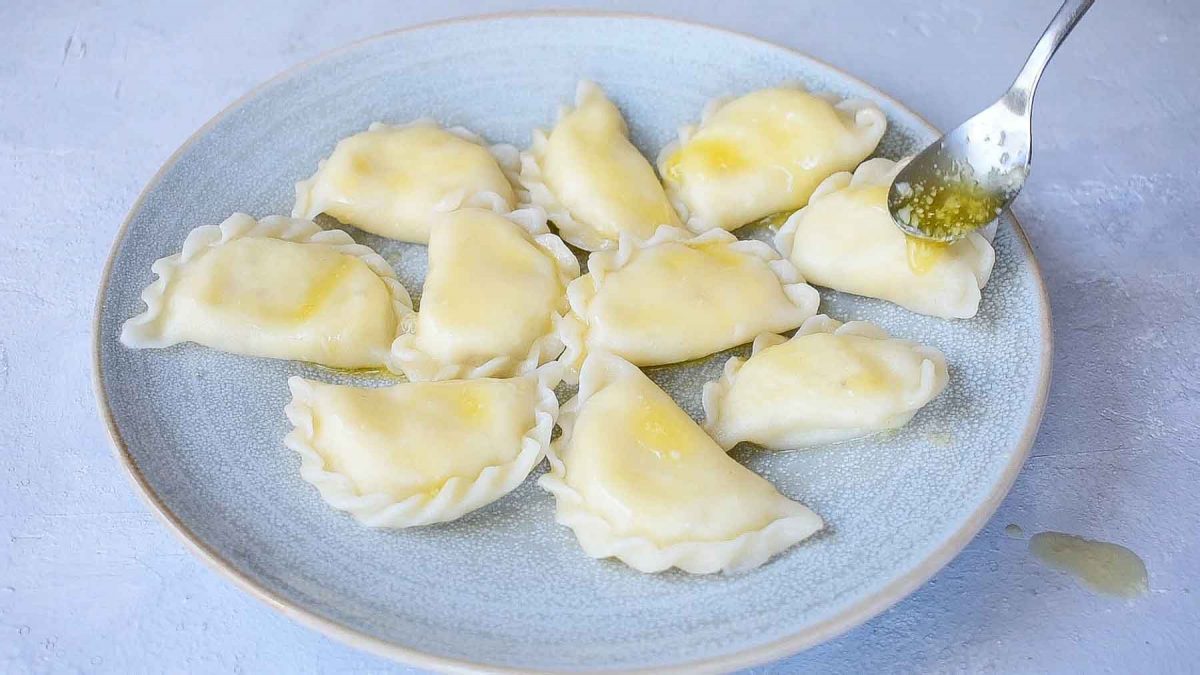
What are pierogi/pierogies?
Pierogi are Polish dumplings, made with unleavened dough and filled with sweet or savory fillings. They are boiled and then sometimes additionally pan-fried.
Pierogi in Poland:
Pierogi are one of the most popular Polish dishes. They are served as a main dish or as a side dish. The most popular pierogi are potato and cheese pierogi, sauerkraut and mushroom pierogi, and pierogi with meat filling (at least in the region where I’m coming from). In summer sweet pierogi (filled with fruits, like strawberries and blueberries) are popular. The flavor combinations are countless.
In Poland you can find small restaurants, where only pierogi are being served, they are filled with many different fillings. Such a restaurant is called ‘pierogarnia’.
Pierogi, Pierogies or Perogies?
Although the word ‘pierogies’ is popularized in English-speaking countries, it is not the true name of these Polish dumplings. The correct name is: singular – 1 pieróg and plural – pierogi. There are no other terms to name it.
What is the difference between pierogi and ravioli:
Ravioli are Italian dumplings, that are wrapped in pasta dough (this dough must contain eggs and is more rich and tough). Italian fillings also differ from traditional pierogi fillings.
Top tips for making the perfect pierogi dough:
- Traditional pierogi dough is easy to make without a recipe (I think no Polish grandmother makes it with a recipe, at least both my grandmothers don’t). The exact recipe is not important here, if the dough is too dry, you need to add some water, if too wet – a little bit of flour. However, it is worth having your favorite recipe and a kitchen scale on hand – the preparation goes much faster, the ingredients are added into a bowl and kneaded together, you don’t need to add additional water or flour.
- One of the most important things is, that the dough is well-kneaded!
- After kneading the dough, let it rest. You can see on my video how much softer and pliable the dough is after it has rested.
- Best water temperature – very hot but not boiling.
- Add some fat – it can be butter (more flavor) or oil.
- Don’t add eggs to the dough (more on that below).
- Dough to filling ratio: it’s very important, but it’s also a matter of taste. I like it when my dough is not very thin but also not very thick. I like to stuff my pierogi with lots of filling but I also like to taste the dough. Experiment what works best for you.
Easy pierogi dough ingredients:
- The best flour to make pierogi – I’m using all-purpose flour.
- Water – it’s important to add hot water to the dough. It makes the dough soft and pliable. You should warm the water with butter until they are very hot, but not boiling (temperature around 80-90 °C / 176-194 °F, that is when the water starts to move and steam). Too hot water will make the dough a little bit more chewy and sticky. Cold water will make the dough harder to roll out and it will be more difficult to shape the pierogi.
- Fat – you could make the dough without it, but it really makes the dough perfect. I’m using butter for its taste but any vegetable oil will also work.
- Salt – also the dough should be seasoned, not only the filling.
- I’ve seen some recipes that call for sour cream. Personally, I’ve never heard of such pierogi dough ingredient and don’t know anyone who is making pierogi with it (at least in Poland). I think it’s more an American or Russian/Ukrainian ingredient. Nowadays though, many home cooks experiment with the ingredients. Authentic Polish pierogi dough recipe call just for flour, water, salt, and optionally some fat and an egg.
Pierogi dough with egg or no egg:
There are two ways of making the pierogi dough – with or without an egg. Many Polish home cooks are arguing, which way is the best.
For me, the perfect pierogi dough is made without the egg. The dough with eggs is a bit tougher in my opinion, but the difference with a well-kneaded dough is not that huge (but there is a difference).
The second reason why I don’t add an egg is that it’s more hygienic – having a small child at home, I usually make a lot of pierogi in one batch, but making a lot of breaks in between. I do not have to worry about washing my hands thoroughly all the time, taking care if the table is well cleaned and watching out if my daughter is eating a dough with a raw egg.
By the way, you should try making pierogi with your kids. Rolling out the dough, cutting out rounds, shaping the pierogi – I think it’s a fascinating activity for every child!
Since this pierogi dough is made without eggs it is suitable for vegetarian diet, vegan diet or dairy-free diet (swap the butter for vegetable oil), or egg-free diet.
What equipment do you need:
- I love making my pierogi dough in my Kitchen Aid but you can also make it by hand. You’ll need to knead the dough for about 10 mins. A food processor can also be used (fitted with the dough blade), but I prefer the stand mixer.
- A rolling pin (or alternatively a wine bottle!). For rolling out the dough you can use a pasta maker (I’m sometimes using my Kitchen Aid pasta attachment). I find that it’s equally easy to roll out the dough by hand and with the pasta maker. Pierogi dough is much more pliable and soft in comparison to pasta dough, which makes it easier to roll out by hand.
- Pierogi cutter / pastry cutter / a cup (preferably with sharp edges). I prefer to use a real pierogi cutter or a pastry cutter – it’s easier to cut out rounds. A regular glass/cup can also be used but I find cutting out round a little bit harder as its edges are more thick and blunt. It would be better to use a glass that has thin, sharp edges if you don’t have a pierogi cutter (both my grandmas are using a regular glass though ;)).
- A pot to cook the pierogi (obviously) and a slotted spoon.
- There are pierogi maker press or pierogi molds available if you search online. I haven’t personally tried them out. Feel free to let me know if there are any that you really like!
How to make pierogi dough – step by step:
STEP 1: Add flour and salt to a large bowl.
STEP 2: Add hot water with butter.
STEP 3: Mix with a wooden spoon until roughly combined.
STEP 4: Knead the dough until smooth and soft.
STEP 5: Prepare the filling.
STEP 6: Roll out the dough and cut out the rounds.
STEP 7: Place the filling on the round.
STEP 8: Shape the pierogi. Ready to be cooked!
How to measure the flour:
In the recipe card below, I provided all possible measurements for the pierogi dough – by volume and by weight. I’m always using a kitchen scale to make my pierogi (and generally to develop the recipes on my website). If you’re weighing your ingredients on a scale your results will be very consistent and the same as mine. It’s really easier, quicker and a kitchen scale is super cheap!
If you’re measuring the flour with measuring cups there is a possibility that you will add more or less flour than I did. You need to check the consistency of the dough and add more flour if it’s too wet and more water if it’s too dry and too tough.
Measuring the flour with measuring cups is unfortunately very inaccurate. 1 US cup of flour can weigh from 120g-140g, depending on how you fill the cup. 20g is a little over 2 tablespoons of flour, so when this recipe calls for 4 cups of flour, you could have added 8 tablespoons more flour which is 1/2 cup! For measuring flour I’m spooning the flour into the measuring cup with a tablespoon and not scooping it with the cup. Level the flour with the back of the knife and don’t tap the cup or press down the flour. Read this article for more information on how to measure flour.
1 US cup is 240 ml. An European cup is 250 ml!
How to roll out the dough with a pasta maker:
Pierogi dough can also be rolled out using a pasta machine. I have a Kitchen Aid pasta roller attachment. I roll out the dough on setting 4. According to the manufacturer’s instructions you need to roll out the dough on each setting until you get to the setting 4. I’m not doing this, pierogi dough without an egg is easier to roll out than an egg dough or pasta dough. To make it possible, the dough must be well sprinkled with flour, at room temperature, slightly rolled out with a rolling pin (to a thickness of approx. ¾ cm / ½ inch) and smooth (otherwise will tear).
How to store pierogi:
To ensure that the cooked pierogi don‘t stick to each other, brush them lightly with melted butter or oil. Store in a tightly-closed container in the fridge for about 2 days. On the next day, it‘s best to pan-fry them with butter until golden.
Freshly cooked pierogi taste best for me, so I usually do this: I prepare only the amount of dumplings that we are going to eat on a given day (about 14 per person, my pierogi are rather small, see the video for the reference). I wrap the rest of the dough tightly in plastic foil and put it in the fridge. I place the rest of the filling (or make filling balls from all of the filling) and also tightly wrap in plastic foil and put in the fridge. On the next day (or even on the third day) I’m preparing the rest of the pierogi.
If I have more time and I’m making more pierogi in one batch, I freeze them or pan-fry with butter the next day.
After removing the dough from the fridge, it is good to slightly warm it up (leave it for about 15-30 minutes on the counter), it will be more elastic (this is optional). The next day the dough can look a little gray in color, but we don‘t mind that.
Freezing tips:
- Cooked pierogi: Place the pierogi apart on a tray, sprinkled well with flour. Freeze until solid. Transfer to containers on plastic bags. Cook like fresh pierogi but take them out once they float on the water surface.
- Uncooked pierogi: Note that not boiled raw pierogi are more likely to crack in a freezer than cooked pierogi. I most often freeze raw pierogi though. Place the pierogi on a tray / wooden board sprinkled well with flour (important, dumplings can easily stick to the tray and tear). Arrange the dumplings so that they do not touch each other. When frozen, transfer them into containers or plastic bags. I cook frozen dumplings just like fresh ones, with the difference that you can cook a smaller amount of them at a time, I cook max. 7-8 frozen pierogi at once (and about 10-12 fresh). When you drop too many frozen pierogi at once it will lower the temperature of the water too much and they will burst.
Store-bought frozen pierogi:
I’ve never eaten store-bought frozen pierogi that tasted amazing (maybe I’m just spoiled with homemade pierogi!). In terms of taste, some of them were not that bad, but for me, the dough is always too thick. This is not surprising since these pierogi are not made by hand. The dough manufactured in a factory need to be thicker so it won’t easily break and can be filled by a machine. Homemade pierogi all the way!
FAQ:
Knead the dough well then let it rest before rolling it out. A good recipe is also important – add butter and hot (but not boiling) water to the dough.
Toss the hot, freshly cooked pierogi with butter or oil until coated on all sides.
You can freeze cooked pierogi or uncooked pierogi. See the instructions above.
There’s no need to do that. You can throw frozen pierogi direct into boiling water.
I like to keep it simple and just pour melted butter over them. Other options are: sauteed/caramelized onions, pan-fried bacon, chopped parsley. Sweet pierogi are often served with sweetened heavy cream/sour cream.
Here you’ll find all my pierogi sauces and toppings ideas.
Yes! You can wrap the filling in shortbread pastry and bake until golden. This kind of pierogi is not that popular but in some regions, people are making baked pierogi.
Your dough was probably not evenly rolled out. Thicker pierogi will be a bit bigger, also when you fill them with more filling. If the dough is of the same thickness you can cook the small and big pierogi the same way.
Cut it into thick strips and use as pasta eg with soup.
It’s probably not well-kneaded, not rested or you’ve used cold water. It’s also possible that you’ve added too much flour – add more water until the dough is smooth and soft.
It really depends on your preferences. I really dislike dough that is rolled out too thick. When the dough is thinly rolled out it literally melts in your mouth after you cook the pierogi.
It will take a minimum of 5 minutes by hand and about 3 minutes in a stand mixer. It can take longer or shorter. You need to pay attention to the dough’ consistency – it should be smooth and soft (check out the video to see the consistency of the dough). It will be even softer when it’s rested.
The dough can be too elastic and shrink as you try to roll it out when it’s not rested. Make sure to rest the dough for about 20-30 minutes, then it should be easy to roll out. This is caused by gluten that is in every type of wheat flour.
Filling recipes:
I have a separate post, where I talk about all the traditional and modern pierogi filling ideas.
Here are the written recipes:
- authentic potato and cheese pierogi (pierogi ruskie) – with potato, twaróg cheese, and onion filling
- potato and cheese pierogi the American way (cheddar pierogi)
- sauerkraut and mushroom pierogi
- spinach and feta pink pierogi (basic pierogi dough is colored with beetroot juice!) with potatoes, onion, feta cheese, and spinach filling
- vegan/vegetarian pierogi with spicy lentil and sun-dried potato filling
- uszka (‘little ears’) pierogi – porcini (wild mushroom) filled mini pierogi for Christmas Eve Borscht
- sweet cheese pierogi
The best pierogi dough recipe + how to make perfect pierogi
Ingredients
- 4 cups flour 500g / 17.5-oz, spoon and leveled, all-purpose flour
- 1 cup + 2.5 Tbsp water 280g / 280ml / 10-oz (to weight on a scale)
- 3 tablespoons butter 1.4 oz/40g, or vegetable oil
- 1 teaspoon salt
Would you like to save this?
Instructions
→ Make the dough:
- Add the flour and salt into a large bowl, mix together.
- In a small saucepan, warm the water with butter until they are very hot, but not boiling (temperature should be around 80-85 °C / 176-185 °F, that is when the water starts to move and steam).
- Pour hot water with butter into the bowl with flour, mix with a wooden spoon until roughly combined.
- Knead the dough using your hands or with a stand mixer fitted with a hook attachment, for about 5 minutes. A food processor can also be used (fitted with the dough blade). The dough should be smooth, soft, and elastic, it shouldn’t stick to your hands. When you follow the recipe (especially if you weigh the ingredients, instead of using measuring cups), the dough should be perfect, but if for some reason it’s not, add some water if it’s too dry, or a little bit of flour if it’s too wet. If the dough already forms a ball, is relatively smooth, but still tough, it means that it’s not ready, it must be further kneaded until soft and elastic (after resting time it will be even softer).
- Wrap the kneaded dough in plastic foil (so it doesn’t dry out), leave to rest for about 30 minutes (it will be easy to roll out).
→ Rolling out, stuffing and shaping the pierogi:
- Divide the dough into 4 parts.
- Onto a lightly floured surface, roll out thinly the first piece of the dough, to a thickness of approx. 2 mm / 1/16 inch. If the dough is hard to roll out, set it aside for about 5-10 minutes to rest.
- Use a cup or a pierogi/pastry cutter to cut out rounds. Place one ball of filling / 1 teaspoon of filling on each round.
- Gather scraps, cover with plastic wrap and set aside.
- Fold the dough over the filling to create a half-moon shape. Press edges together, sealing and crimping with your fingers. Do not leave any gaps or pierogi may open during cooking.
- Place the pierogi apart on a towel lightly sprinkled with flour (this is important, they can stick to the board), cover loosely with a kitchen cloth so that they don‘t dry out.
- Repeat with the remaining dough.
-> Cook the pierogi:
- Bring a large pot of salted water to a boil.
- Cook the pierogi in batches (for a 21 cm /8-inch pot I cook about 10-12 dumplings at a time). When they float to the water surface cook them for 1-2 minutes, then remove from the water with a slotted spoon. The cooking time will depend on the thickness of the dough.
- Drain well and transfer onto a plate. Serve warm, pour over some melted butter.
- Enjoy!
Notes
To ensure that the cooked pierogi don‘t stick to each other, brush them lightly with melted butter or oil. Store in a tightly-closed container in the fridge for about 2 days. On the next day, it‘s best to pan-fry them with butter until golden.
Freshly cooked pierogi taste best, so I usually do this: I prepare only the amount of pierogi that we are going to eat on a given day (about 14 per person). I wrap the rest of the dough tightly in plastic foil and put it in the fridge. I place the rest of the filling (or make filling balls from all of the filling) and also tightly wrap in plastic foil and put in the fridge. On the next day (or even on the third day) I’m preparing the rest of the pierogi. If I have more time and I’m making more pierogi in one batch, I freeze them or pan-fry then with butter the next day.
After removing the dough from the fridge, it is good to slightly warm it up (leave it for about 15-30 minutes on the counter), it will be more elastic (this is optional). The next day the dough will be a little gray in color, but we don‘t mind that. – How to freeze pierogi: Cooked pierogi: Place the pierogi apart on a tray that is sprinkled well with flour. Freeze until solid. Transfer to containers on plastic bags. Cook like fresh pierogi but take them out once they float to the water surface. Uncooked pierogi: Note that not boiled raw pierogi are more likely to crack in a freezer than cooked pierogi. I most often freeze raw pierogi though. Place the pierogi on a tray / wooden board sprinkled well with flour (important, dumplings can easily stick to the tray and tear). Arrange the dumplings so that they do not touch each other. When frozen, transfer them into containers or plastic bags. I cook frozen dumplings just like fresh ones, with the difference that you can cook a smaller amount of them at a time, I cook max. 7-8 frozen pierogi at once (and about 10-12 fresh). When you drop too many frozen pierogi at once it will lower the temperature of the water too much and they will burst. – Rolling out with pasta machine: I have a Kitchen Aid pasta roller attachment. I roll out the dough on setting 4. According to the manufacturer’s instructions you need to roll out the dough on each setting until you get to the setting 4. I’m not doing this, pierogi dough without an egg is easier to roll out than an egg dough or pasta dough. To make it possible, the dough must be well sprinkled with flour, at room temperature, slightly rolled out with a rolling pin (to a thickness of approx. ¾ cm / ½ inch). and smooth (otherwise will tear). – 1 cup is 240 ml. – The amount of pierogi: based on the feedback that I got from readers, the amount of pierogi you’ll get from this recipe can vary greatly! My pierogi are rather small and I like to pack them with a lot of filling, that’s why I got 100 pierogi from this recipe. This may be different for you and you can get only half of this amount.
Did you make this recipe? RATE THE RECIPE or tell me in the COMMENTS how you liked it! You can also add a photo of your dish. It would make me very happy and will help other readers. Thank you!!


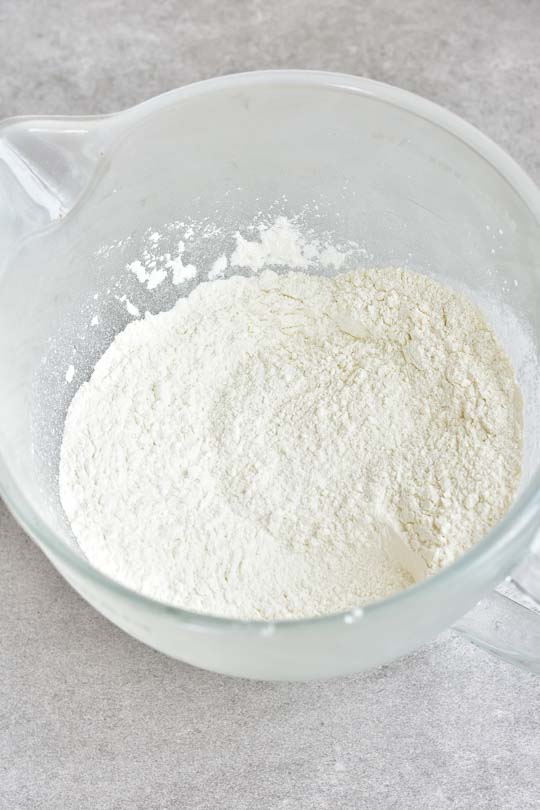
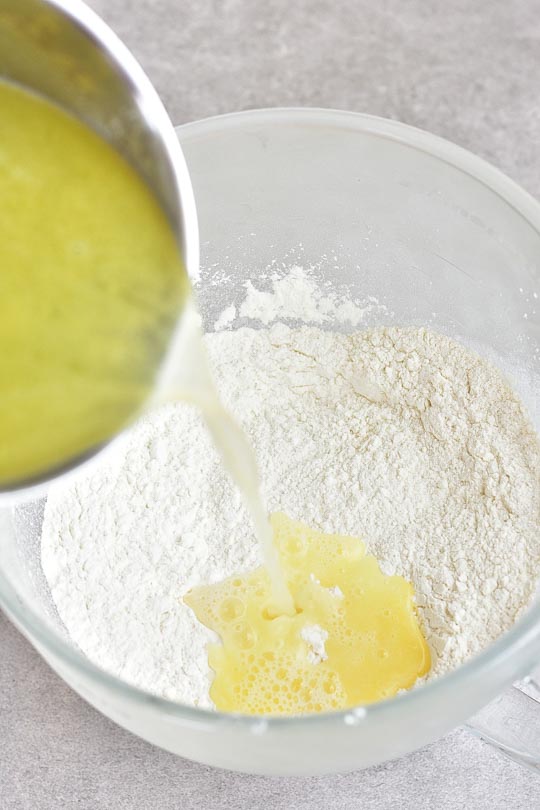


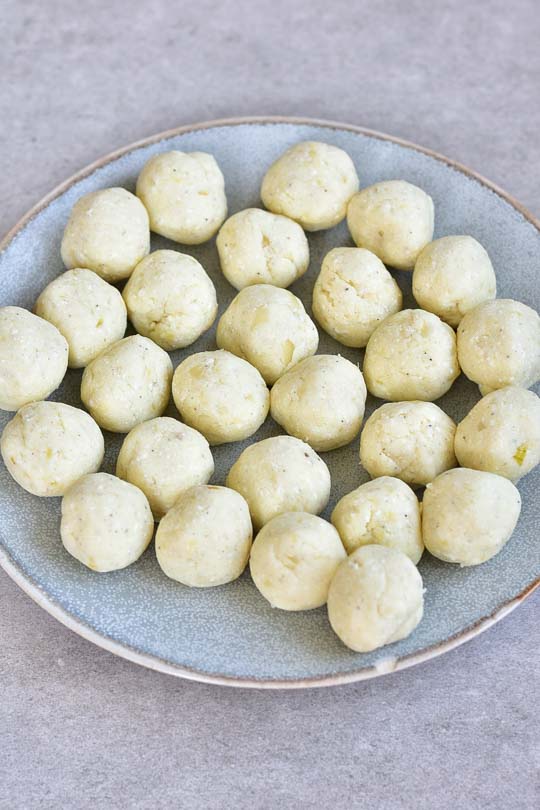
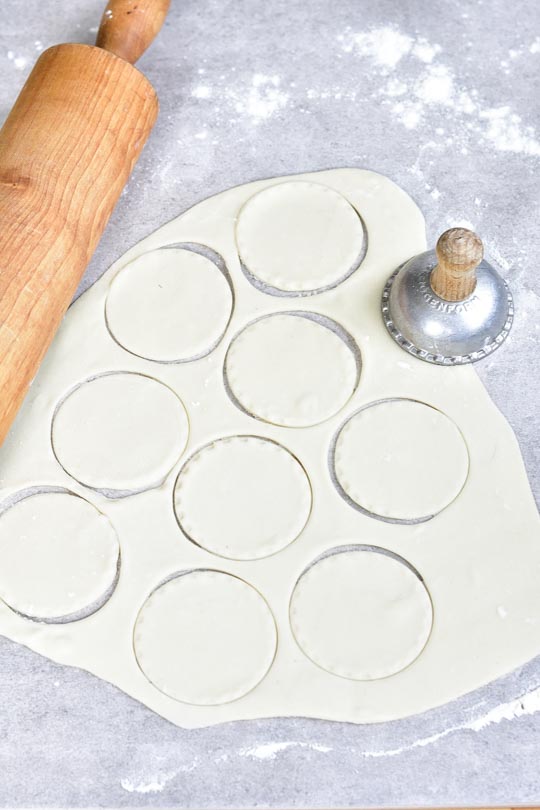
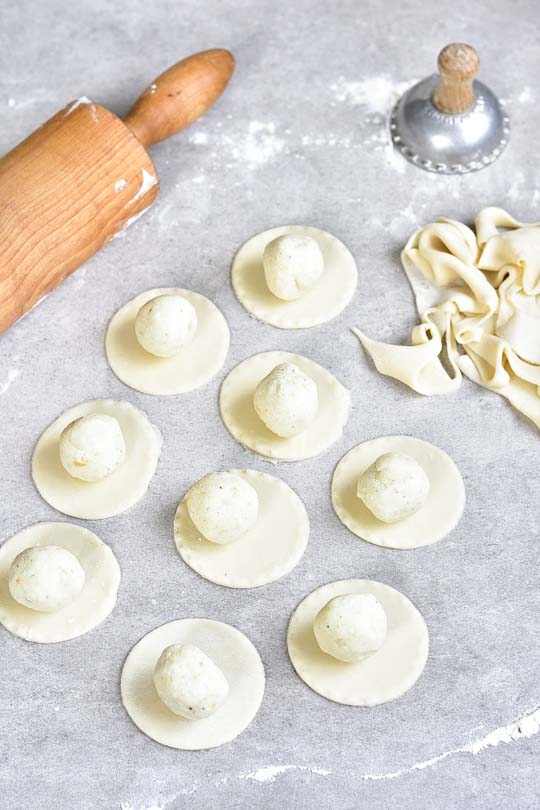
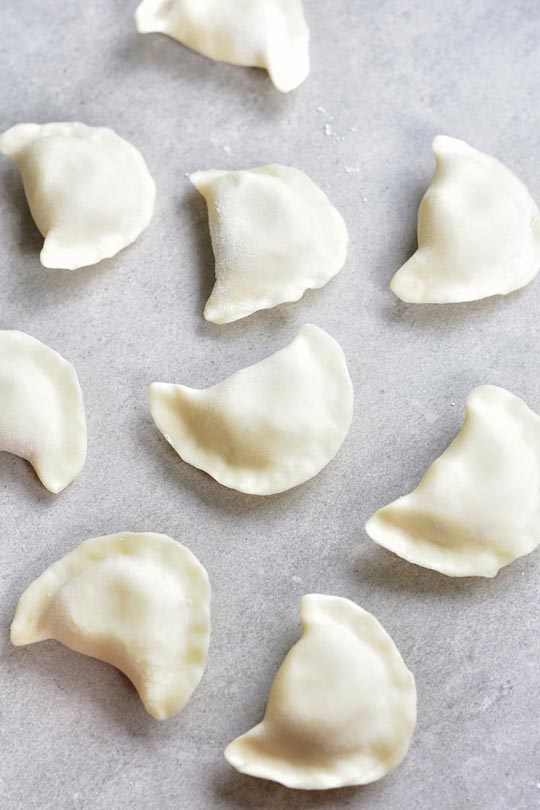
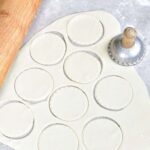
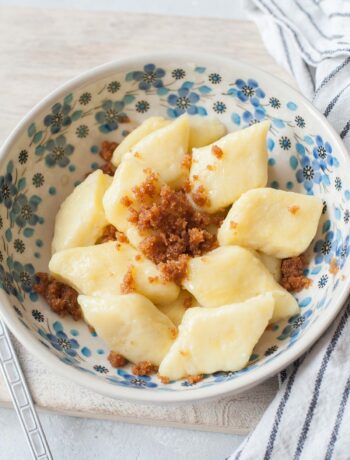
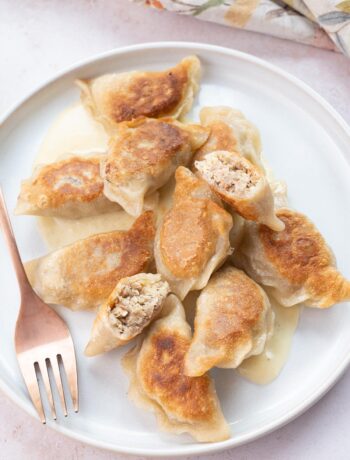

386 Comments
Tia
14 January 2021 at 03:58Lovely recipe, turned out delicious!There were leftovers, and now I’m hoping to send it to school with my son in a Mr. Bento insulated thermos. It keeps food hot for about six hours, so assuming I heat everything thoroughly it should stay hot. But will the pierogis stick together if sitting at a high temperature for so long? Would you cover them in butter and then make sure it’s really hot?
Aleksandra
14 January 2021 at 08:11I would cover them in butter to be sure, they are more delicious this way, anyway
Milos
16 January 2021 at 13:35Fantastic recipe with good tips.
Aleksandra
16 January 2021 at 14:50Thanks, Milos!
Colette Balder
13 January 2021 at 19:07Question: How should I divide the dough if using the Kitchen Aid pasta attachment? In fourths? Eighths? The attachment will make a 4 inch wide strip with a variable length. With a 3 inch cutter I could only get one circle wide. Help!
Aleksandra
13 January 2021 at 19:21I guess into 8 parts but I’m not sure (I used this attachment some time ago!). To be honest, I’ve found that for me it goes quicker to roll it out by hand than with this attachment. I think you just have to try until you get it right. Sorry I can not be of more help. I will try to pay attention to it next time I will be making pierogi.
I know that many readers have used this attachment, maybe someone else will help?
Colette Balder
13 January 2021 at 22:34I just went ahead and rolled it. BEAUTIFUL piece of dough–a real joy to work with. No sticking, no cracking, just awesome. Forget using the attachment; it’s really not needed. Plan to cook for dinner tonight. Can’t wait!
Fay
7 January 2021 at 00:10I made your dough and made pierogi’s for my first time!
I totally loved working with this dough it was best dough I ever worked with. After I finished my piergo’s I had some dough left over and I cut some apples in small chunks, added raisins ,butter, brown sugar and cook till done. Filled each circles with 1 tsp. apples and when done sprinkle with confectionery sugar. They where amazing, Thanks again!
Aleksandra
7 January 2021 at 06:45Great idea for the filling, thank you!
Justine Kilbride
5 January 2021 at 22:10Weighed ingredients as instructed and dough was perfect.Really like your crimping technique but have to practice a bit. Used oil and made filling vegan with potatoes, vegan butter and a touch of vegan mayonnaise.“You made these from scratch?” My son who is not vegan came for dinner and asked if he could come back tomorrow.
Aleksandra
6 January 2021 at 07:33Thanks for trying out my recipe, I’m happy you liked it!
Tammie
4 January 2021 at 05:54Hi
About to make this recipe and just wanted to verify there is no yeast in the dough?
Thank you
Aleksandra
4 January 2021 at 06:41No, pierogi are not made with yeast.
Chris Dovbniak
3 January 2021 at 21:03We found the dough hard to work with. Your recipe says this should produce 100 pierogi. We ended up with under 50 with a lot of filling left over. The cutter was just over 3 inches in diameter. We weighed ingredients as suggested.
Aleksandra
3 January 2021 at 21:23I’m really sorry to hear that Chris! Why was the dough hard to work with? Was it hard to roll out? have you rested the dough? Was the water warm enough? Did you add butter/oil? I can help you troubleshoot if you write a little bit more details. My cutter is 2 3/4 inches in diameter and I really like to pack a lot of filling into my pierogi. I made them for Christmas this year again, and as written in the recipe card, I got exactly 98 pierogi (I made my sauerkraut pierogi).
Diane
31 December 2020 at 15:57This recipe was perfect for a homemade pierogi newbie like me! better than the frozen ones from the grocery store. Quick question though. I boiled the pierogi and then froze them. The next day I defrosted them for 1/2 hour and then panfried them. They came out perfect. I see by your instructions that frozen cooked pierogi should be boiled again. Is this only done if they are being served right from the boiling water, or do you like to do it again even when pan frying?
Aleksandra
31 December 2020 at 17:55I’m happy to hear that, Diane! I boil the frozen pierogi just to thaw them and warm them up (I throw them into the boiling water straight from the freezer). If you already thawed your pierogi and then pan-fried them, this is fine! I usually freeze raw pierogi (not boiled).
Peter
28 December 2020 at 19:12I was very satisfied with the recipe (not my first time making pierogis) up until the boiling point. After boil, the dough was very soft – almost as if it was undercooked. What could have caused this? The only thing I improvised with was melting my butter and dissolving my salt in the hot water – everything else was followed step by step. Should I have not melted butter or dissolved salt in the water? Maybe used less butter? Cook shorter or longer? Willing to try again to get the right consistency in the outcome.
Aleksandra
28 December 2020 at 20:37Hi Peter, thank you for trying out my recipe. The butter should be melted and dissolving salt does not matter. Salt is added only to season the dough. I think maybe you overcooked your pierogi and that’s why they were too soft? Or maybe you’re used to chewier pierogi. These pierogi should be soft, as one reader has written a couple of comments below, they ‘melt in your mouth’. If you would like to give this recipe another try I would test cook 1 pierog and cook it just until it floats to the surface of the water, then cook the next pierog for 1 minute after floating to the surface, and the next for 2 minutes. This will tell you how to achieve the right consistency for you. Hope this helps!
natasha
27 December 2020 at 02:16this is my second time making pierogi (the first time i used the king arthur flour recipe, which contains several of the ‘sins’ mentioned in this post) and oh my GOODNESS these turned out so much better! the dough was unbelievably soft and pliable and made the best pierogi – perfect! i even fed them to a polish person who said these were some of the best he’s ever had. definitely a keeper recipe!
Aleksandra
27 December 2020 at 08:37Hi Natasha, I’m glad to hear that!
Kristie
25 December 2020 at 20:20This is the 3rd recipe I’ve tried and it is by far the best! Perfect dough, great tasting and easy to make. I boiled and then pan-seared the pierogi, and paired it with bigos for a simple and traditional Polish Christmas Eve for 2.
Aleksandra
25 December 2020 at 21:36Hi Kristie! I’m happy to hear that you liked the recipe! Thank you so much for the photo, everything looks delicious. Merry Christmas to you and your family!
Rose from Pa
24 December 2020 at 22:54Just made them and they were perfect. We made the dough and rolled it out in our kitchen aid pasta dough roller. Used the largest circle cookie dough cutter we had. Put water on fingers to press close and then kids used fork to crimp the edges. Definitely this will be our holiday tradition!
– cheese potato onion filling:
Five potatoes. Boiled and mashed.
7.5 ounces farmers cheese
Two tablespoons sharp cheddar cheese
Chopped fried onion
Garlic powder. Salt and pepper.
– dough and filling made over 40 mini pierogi.
Aleksandra
25 December 2020 at 06:37Thank you, Rose. The filling sounds delicious, I will definitely try that!
Pete
24 December 2020 at 15:33My experience was that even though I weighed everything out the dough was too dry. I had to add about 3 tbsp of water to a half batch of dough. Also, I made my pierogie 4 inches in diameter and only got about 22 per half batch of dough. Rolled them pretty darn thin so I’m wondering how you get 50 out of a half batch. I doubt you’re making 2 inch pierogie!
Aleksandra
24 December 2020 at 17:24Hi Pete, I’m sorry to hear that you had trouble with the recipe. Since you’ve weighed everything out and you needed to add more water to the dough, I’m guessing maybe the flour was the culprit? What kind of flour have you used? Every flour absorbs a different amount of water, sometimes you just have to add more water or flour to the dough, this is ok as long as the end result is good! My pierogi cutter’s diameter is a little less than 3-inches so they come out rather small/medium (you can see on the video how big they are).
Patti Robinson
22 December 2020 at 21:33This is the best dough recipe ever. I love that the dough doesn’t spring back when you roll it out. The best part is i didn’t have to flour and surfaces when I rolled the dough. I rolled them out on my kitchen mat and ran each piece of dough through my pasta attachment to my mixer. The best part of this recipe is there is no chewy corners. Melts in your mouth. I filled them with just 1-lbs of Farmers Cheese, mixed with half a teaspoon of salt and two beaten eggs.
Aleksandra
23 December 2020 at 04:58I’m happy to hear that, Patti! Thanks for commenting!
Meg
19 December 2020 at 01:11Hello – looking forward to making this! Can the recipe be doubled with the same results?
Aleksandra
19 December 2020 at 07:09Yes!
Meg
19 December 2020 at 23:05Thank you!!
Karen
16 December 2020 at 09:14With all the positive comments, I look forward to making your pierogi dough. Could you suggest how many pounds of potatoes to make for one recipe of the dough?
Aleksandra
16 December 2020 at 13:54Hi Karen, I’m glad to hear that, please let me know how you liked it! I have a recipe for potato and cheese filling (either with Polish twarog cheese https://www.everyday-delicious.com/potato-onion-and-white-cheese-pierogi-polish-dumplings-pierogi-ruskie/ or with cheddar cheese https://www.everyday-delicious.com/potato-and-cheese-pierogi/). If you only want to use potato in your filling I would take about 4 pounds of potatoes. Based on the feedback from the readers, this can vary a lot, since some people roll out their dough thicker and some thinner and use a different amount of filling per 1 pieróg. Hope this helps!
Melind
13 December 2020 at 04:41This is THE BEST dough! So tender and easy to whip together! You won’t be disappointed with this! This recipe is a keeper.
Aleksandra
13 December 2020 at 06:26Thank you!
Pat K-N
11 December 2020 at 23:05This was very helpful. Always used a passed down recipes which included sour cream but few instructions. Grateful that you shared your knowledge. Sincere thanks!
linda
10 November 2020 at 20:52I made the pierogi dough by weighing the ingredients. It was spot on!
Thank you. It is my go to recipe.
Aleksandra
10 November 2020 at 21:19I’m happy to hear that, thanks for commenting!
Amanda
29 November 2020 at 01:23I dont know why I can’t create my own comment ha. But this is hands down the best dough I’ve ever tried. Probably my 4th one tried. I weighed as directed and its perfect. I have a question though. When I go to fry them after boiling, they separate. They are fine while boiling but come apart frying. What could I do to fix this?
Aleksandra
29 November 2020 at 06:57I’m glad to hear the recipe works for you 🙂 As for the separating, you mean the sealing right? I’m not sure why this is happening, try to pinch them better before cooking. Have you also tried making a decorative twist aside from just pinching them? This would definitely help. Also make sure that your pan and butter/oil is well heated. To leave your own comment you need to scroll down to the bottom of the page and there is an empty box with stars above it to leave the comment, then you just need to click ‘post comment’. If you’re clicking ‘reply’ you will be replying to someone else’s comment. Hope this helps!
Terri
21 December 2020 at 21:24This was one fabulous recipe! I come from a Polish area of Pennsylvania and currently live in a state that does not know what a pierogi looks or tastes like. I have made them before, but this recipe is superior. It was a delight to make them with my daughter, who was home from college for the holidays. The Polka music was running through my thoughts the whole time. Thank you for the details of this recipe. Even the video was super helpful!
Aleksandra
22 December 2020 at 09:46Hi Terri, thank you for commenting. I’m really happy you liked the recipe!
Kati
2 November 2020 at 06:56This is my second time making pierogi. The first recipe I used had egg, but this method with the melted butter and water was just perfect. The dough rolled out nicely and stuck together perfectly when I folded my dumplings. Have this recipe printed out for future use!
Diane K
25 October 2020 at 20:39I’ve been making pierogi for years and all I can say is thank you, thank you, thank you. Just finished kneading and letting it rest, but this was by far the easiest dough I’ve made yet, kneaded beautifully, soft smooth and pliable dough. I have no doubt this will be the recipe I use going forward.